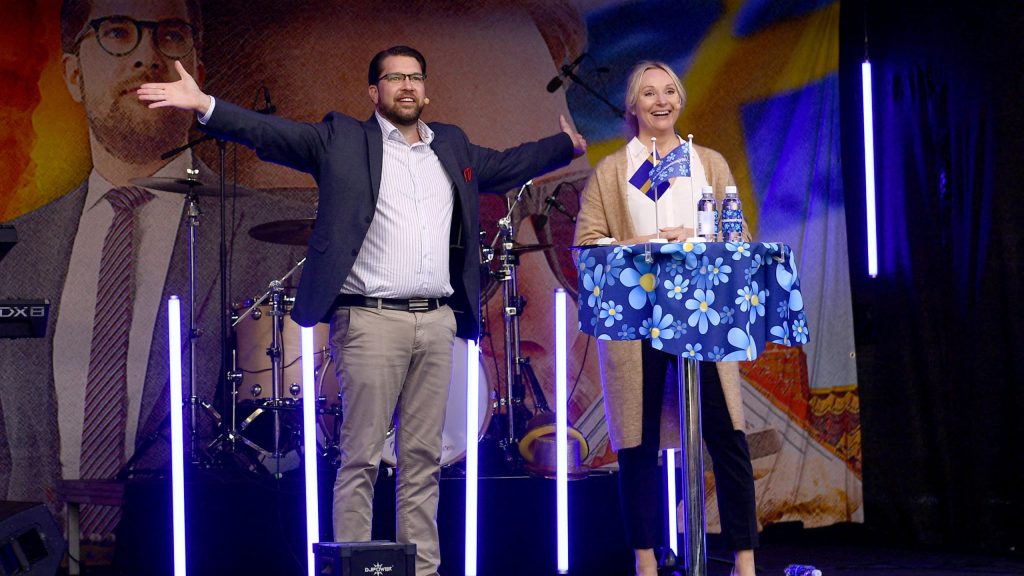The eyes of the world have been on Sweden during its bid for NATO membership. But as voters in the Nordic nation head to the polls for a September 11 general election, domestic issues will be their primary concern.
With gang-related violence spiking in recent years, security, justice, and the failure of immigration policy are top election issues. Crime and migration are closely linked in voters’ minds, with lax migration policies often blamed for rising violence in Swedish suburbs. Many political leaders campaign on harsher criminal sentencing and an expansion of police powers as solutions to reduce crime.
In fact, it was dissatisfaction with the Social Democratic justice minister that nearly toppled the government just two weeks after Sweden submitted its application for NATO membership.
But this election won’t be straightforward. Just as during the previous general election in 2018, neither the traditional center-left nor center-right blocs will likely have enough seats in parliament to form a governing coalition. What has changed in recent years, however, is the willingness of traditional parties to govern with the support of the far-right Sweden Democrats, which are polling at 20.4 percent against the ruling Social Democrats’ 29.8 percent.
Allowing the Sweden Democrats to influence government decision-making would break a long-standing taboo. However, if the traditional center-right parties hope to achieve a change in government after eight years of Social Democratic rule, negotiating with the far-right newcomers who enjoy historically high levels of support will be a political and numerical necessity.
What NATO and the EU are watching
While the domestic debate over Sweden’s NATO membership is settled, the election results may determine how active a role Stockholm will play within the Alliance and the European Union (EU) more broadly.
For the first time in recent memory, security and defense became a top campaign issue for voters, and party leaders still measure their words carefully when talking about Turkey to avoid agitating Ankara—whose veto power could still derail Stockholm’s NATO bid. How to pay for increased defense spending is on the agenda, but with rising inflation and energy prices, many parties are opposed to making voters’ costs of living even more expensive with a special defense tax that the Social Democrats have proposed.
The Social Democrats have broken with their longstanding tradition of upholding military non-alignment. Yet a future center-left government could see its level of engagement in NATO hampered because it would include the Green Party and rely on the support of the Left Party in Parliament—and both parties opposed joining the Alliance.
On the other side of the aisle, members of the center-right bloc are strong supporters of NATO and greater investment in Sweden’s military capabilities. But such a coalition would need the support of the EU-skeptical Sweden Democrats. With Sweden chairing the EU presidency during the first six months of 2023, this may set up roadblocks toward greater EU cooperation at a pivotal moment for the continent.
While the mainstream parties have sought to limit the influence of these two fringe parties, political redlines and campaign promises may fall by the wayside given the numerical realities after election day. Both the Left Party and Sweden Democrats will seek maximalist policy gains in exchange for allowing a government to form.
Everyone’s a kingmaker
Sweden’s system of negative parliamentarism means that a government does not need a parliamentary majority. As long as a majority is not against a government, parties can let a government form with their passive support through abstaining. This occurred in 2018 when the Social Democratic and Green coalition signed the so-called “January agreement” with the Center Party and Liberals, who wished to prohibit the far-right Sweden Democrats from gaining influence.
Since then, the Social Democrats have maintained a precarious coalition marked by numerous twists and turns: Sweden’s first-ever no-confidence vote against a prime minister that successfully toppled the government in mid-2021; the resignation several months later of Prime Minister Magdalena Andersson on her first day in office after losing her Green Party coalition partners over potential Sweden Democratic influence over passing a budget; Andersson’s subsequent re-election to lead a one-party government days later; and the narrow survival of a second no-confidence vote less than a year later.
This year is shaping up to be no less complicated. Forming a government will be equal parts politics and math. Unlike in Germany, a grand coalition between the two largest parties has not been politically feasible. Decades of nearly uninterrupted Social Democratic rule has shaped the identity of the Moderate Party, traditionally Sweden’s second-largest party, as staunch opponents of socialism. Conversely, the Social Democrats’ sheer size has never required them to reach across the aisle; only now, while occupying a historically weak position, have they left the door open to governing with the Moderates, though it is not their “first-hand choice.”
It will be up to the smaller parties—all of which have conflicting interests and different stances on cooperating with the political fringe—to play kingmaker.
Recent polling also indicates that the Sweden Democrats have overtaken the center-right Moderates to become Sweden’s second-largest party. If the Sweden Democrats do finish second, the mainstream political calculus will become even murkier. Leaders have become coy about answering with whom they would build a government as election day draws closer.
Ahead of this weekend’s election, here’s what you need to know about the dynamics in each party:
- From pariah to partner: The Sweden Democrats (polling at 20.4 percent)have experienced a meteoric rise over the past two decades, from gaining only 0.4 percent of the vote in 1998 to becoming Sweden’s third-largest party in 2018. This boost in popularity mirrored a trend across Europe in which far-right populist parties seized on voters’ discontent over rising levels of migration and crime. For years, because of the party’s anti-migration rhetoric and policy, cooperating with the Sweden Democrats was political taboo. Accusations over the party’s neo-Nazi roots in the early 1990s, as well as its continued racism, led it to commission an independent study in July about its own founding and ideological development. According to the author, a majority of the party’s founders had connections to “neo-Nazi, racist, or undemocratic movements.” Party leader Jimmie Åkesson has stated that his party has become politically accepted among voters, having moderated many of their policies and expunging radical members of the party. Center-right leaders, who will need at least the Sweden Democrat’s passive support, also believe the party has changed. But recurring incidents of Sweden Democrats spreading Russian and right-wing propaganda has led many to question this claim; Defense Minister Peter Hultqvist went so far as to hold a press conference just ten days before the election on the national-security risks the Sweden Democrats pose. Åkesson has said he will make “extremely tough demands” upon the Moderates in exchange for his party’s support.
- Struggling socialists: After suffering their worst election results in more than a century during the 2018 election (28.3 percent), support for the Social Democrats (29.8 percent) has somewhat recovered since Andersson took office in November 2021. As Sweden’s first female prime minister, she has navigated her party—Sweden’s largest and longest-ruling—through a radical transformation on its position toward NATO, upending two hundred years of military non-alignment. The Social Democrats’ first choice is to form a center-left coalition with the Greens and Center Party, which means the continued exclusion of the Left Party in government while relying on its tacit support. Andersson has left open the possibility of a centrist coalition with the Moderates, as they have closely worked together on security issues since Russia’s full-scale invasion of Ukraine.
- Retaking power: The Moderates (17 percent)arethe cornerstone of Swedish center-right politics. Between 2006 and 2014, they led the center-right “Alliance,” a coalition with the Liberal Party, Christian Democrats, and Center Party. Under Ulf Kristersson’s leadership, the Moderates have hardened their stance on immigration and justice reform, bringing them more in line with Sweden Democrat positions. Kristersson has opened the door to receiving passive support from the Sweden Democrats, but he excludes the possibility of them becoming a member of the government. In practice, this means negotiating and voting together on a budget.
- Junior partners: The Christian Democrats (6 percent), which have been in the opposition along with the Moderates since 2014,are also open to governing with the support of the Sweden Democrats. Like the Moderates, the Christian Democrats have turned to the right on several issues during this election cycle, such as calling for a 70 percent reduction in asylum-seekers.
- Balancing act: In 2018, the Liberal Party (5.5 percent)broke with the former “Alliance” and gave its passive support to the Social Democrats in order to prevent the Sweden Democrats from gaining any political influence. When the government collapsed in 2021, the Liberals again changed sides and withdrew their support of the Social Democrats. Wanting to see a change in government, new party leader Johan Pehrson has indicated that the Liberals would in fact take the passive support of the Sweden Democrats—but exactly how this relationship would work has become increasingly unclear, and party leadership has faced sharp internal criticism for this shift. Supporting a Social Democratic government again is unlikely, with Pehrson stating “liberalism interacts with socialism like oil and water.”
- Holding the center: As the name suggests, the Center Party (6.6 percent)has called for a broad centrist coalition, rejecting support from both the Left Party and Sweden Democrats. It remains the sole member of the former “Alliance” to continue passively supporting the Social Democrats but faces internal division over this stance. The party has also grown critical of the Moderates’ rightward turn. The Social Democrats need the Center Party to form a center-left government, but substantial negotiation with the Left Party will be required to smooth over differences. Party leader Annie Lööf recently said that she aims to form a coalition with the Social Democrats, but that such a government cannot include the Left Party.
- Aiming for influence: The Left Party (8.4 percent) is the former Communist Party of Sweden. It remains opposed to Sweden’s accession to NATO and may play spoiler in Social Democratic foreign policy if they form a coalition. The party has already caused problems for Sweden’s NATO accession after pictures emerged of parliamentarians posing with flags of the militant Kurdistan Workers’ Party (PKK). The photos handed Turkish President Recep Tayyip Erdogan easy political points and caused headaches for Swedish diplomats when negotiating the terms of agreement for approving NATO membership (which included greater cooperation on combatting terrorism). The party has demanded to be a member of a center-left coalition, or else it will withdraw support for the Social Democrats. After feeling repeatedly steamrolled by the center-left coalition despite their passive support, it was the Left’s de-facto cooperation with the Sweden Democrats over housing policy that brought down the government in 2021.
- Tactical play: For months, the Greens (5.2 percent), who also oppose NATO, were teetering on the verge of missing the 4 percent threshold to enter parliament. As election day has drawn closer, support for them has steadily increased; many Social Democratic voters will vote Green instead, ensuring the much smaller Green Party passes the threshold needed to stay in parliament and lend its support to the Social Democrats in a center-left coalition.
A generational election
Nearly every election is billed as high-stakes. In 2022, that may actually be true: The new government will be responsible for Sweden’s first steps into NATO. After two hundred years of military non-alignment, decisions taken today about the type of ally Sweden will be within NATO will set the course for the nation’s relationship toward Europe and the transatlantic community for a generation.
Aaron Korewa is the director of the Atlantic Council’s Warsaw office.
Eric Adamson is a project manager at the Atlantic Council’s Northern Europe office in Stockholm.
Further reading
Wed, May 18, 2022
Sweden would strengthen NATO with fresh thinking and an able force
New Atlanticist By John R. Deni
Sweden’s unique characteristics could make it a serious security provider—not merely a security consumer—in the heart of Northern Europe.
Mon, Aug 8, 2022
When will Sweden and Finland join NATO? Tracking the ratification process across the Alliance.
New Atlanticist By
With this tracker, the Atlantic Council team is keeping tabs on the countries that have ratified the amended NATO treaty—and handicapping the political prospects for ratification in the rest.
Fri, Jul 22, 2022
Now for the hard part: A guide to implementing NATO’s new Strategic Concept
New Atlanticist By Hans Binnendijk, Timo S. Koster
NATO should be proud of its recent accomplishments—but now it needs to follow through.
Image: Sweden Democrats leader Jimmie Akesson and Jessica Stegrud attend a campaign rally in Vasteras, Sweden, on September 7, 2022. Photo by Tim Aro/TT News Agency/via REUTERS



